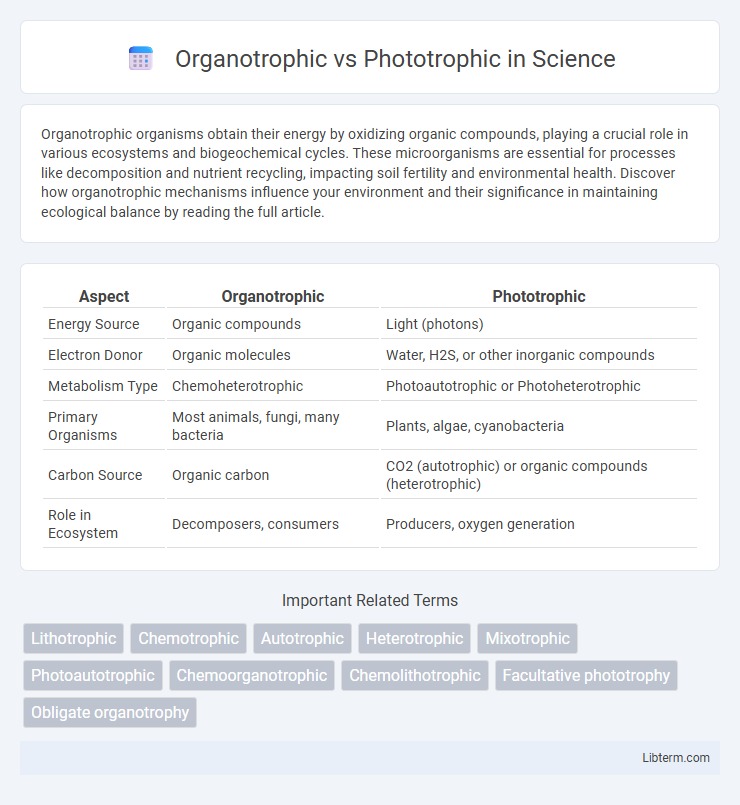Organotrophic organisms obtain their energy by oxidizing organic compounds, playing a crucial role in various ecosystems and biogeochemical cycles. These microorganisms are essential for processes like decomposition and nutrient recycling, impacting soil fertility and environmental health. Discover how organotrophic mechanisms influence your environment and their significance in maintaining ecological balance by reading the full article.
Table of Comparison
| Aspect | Organotrophic | Phototrophic |
|---|---|---|
| Energy Source | Organic compounds | Light (photons) |
| Electron Donor | Organic molecules | Water, H2S, or other inorganic compounds |
| Metabolism Type | Chemoheterotrophic | Photoautotrophic or Photoheterotrophic |
| Primary Organisms | Most animals, fungi, many bacteria | Plants, algae, cyanobacteria |
| Carbon Source | Organic carbon | CO2 (autotrophic) or organic compounds (heterotrophic) |
| Role in Ecosystem | Decomposers, consumers | Producers, oxygen generation |
Introduction to Organotrophic and Phototrophic Organisms
Organotrophic organisms obtain energy by oxidizing organic compounds, playing a crucial role in ecosystems by decomposing organic matter and recycling nutrients. Phototrophic organisms capture light energy through pigments such as chlorophyll, enabling photosynthesis and supporting primary production in diverse environments. These metabolic strategies underline fundamental differences in energy acquisition that shape microbial ecology and ecosystem dynamics.
Definition of Organotrophy
Organotrophy refers to a metabolic process in which organisms obtain electrons for respiration by oxidizing organic compounds, serving as electron donors. This contrasts with phototrophy, where organisms harness light energy to drive electron transport and energy production. Organotrophic organisms include many bacteria and fungi that rely on organic molecules such as carbohydrates or lipids to generate energy through cellular respiration or fermentation.
Definition of Phototrophy
Phototrophy is a metabolic process where organisms capture light energy to synthesize organic compounds, primarily through photosynthesis. Phototrophic organisms include plants, algae, and certain bacteria that utilize pigments like chlorophyll to convert sunlight into chemical energy. Unlike organotrophs, which rely on organic compounds for electron donors, phototrophs depend on light as their primary energy source.
Key Differences Between Organotrophic and Phototrophic Metabolism
Organotrophic metabolism relies on the oxidation of organic compounds to obtain energy and electrons, primarily occurring in heterotrophic organisms such as humans and many bacteria. Phototrophic metabolism harnesses light energy to drive electron transport and ATP synthesis, characteristic of plants, algae, and certain bacteria using chlorophyll or bacteriochlorophyll pigments. Key differences include the energy source--organic molecules for organotrophs versus light for phototrophs--and their electron donors, which are organic compounds in organotrophs and often water or hydrogen sulfide in phototrophs.
Energy Sources: Chemical vs Light
Organotrophic organisms derive energy by oxidizing organic compounds, using chemical reactions to convert nutrients into usable cellular energy. Phototrophic organisms capture light energy through photosynthesis, utilizing pigments like chlorophyll to transform sunlight into chemical energy. The fundamental distinction lies in organotrophs relying on chemical energy from organic molecules, whereas phototrophs depend on light as their primary energy source.
Examples of Organotrophic Organisms
Organotrophic organisms obtain energy by oxidizing organic compounds, typically including bacteria such as Escherichia coli and fungi like Saccharomyces cerevisiae. These organisms utilize organic molecules as electron donors to support cellular respiration or fermentation processes. In contrast, phototrophic organisms like cyanobacteria and green algae harness light energy through photosynthesis for growth and energy production.
Examples of Phototrophic Organisms
Phototrophic organisms include cyanobacteria, green sulfur bacteria, purple non-sulfur bacteria, and algae such as green algae and diatoms, all of which harness light energy through photosynthesis. These organisms utilize pigments like chlorophyll and bacteriochlorophyll to capture solar energy, converting carbon dioxide and water into organic compounds and oxygen in oxygenic phototrophs or utilizing alternative electron donors in anoxygenic types. Phototrophic organisms play vital roles in ecosystems by contributing to primary production and oxygen generation, differentiating them from organotrophic organisms that derive energy from organic compounds.
Ecological Roles and Significance
Organotrophic organisms obtain energy by oxidizing organic compounds, playing a crucial role in decomposing organic matter and recycling nutrients in ecosystems, particularly in soil and aquatic habitats. Phototrophic organisms harness light energy through photosynthesis, producing oxygen and serving as primary producers that sustain food webs in terrestrial and marine environments. The balance between organotrophic and phototrophic activity supports ecosystem stability and nutrient cycling, influencing biodiversity and carbon fluxes globally.
Evolutionary Perspectives
Organotrophic organisms, deriving energy from organic compounds, likely evolved after phototrophic organisms, which harness light energy through photosynthesis, reflecting a fundamental shift in metabolic strategies driven by environmental oxygenation. The emergence of phototrophic cyanobacteria during the Great Oxygenation Event dramatically altered Earth's atmosphere, enabling the evolution of diverse organotrophic life forms dependent on oxygen-rich environments. This evolutionary transition highlights the adaptation from ancient autotrophic pathways to more complex heterotrophic metabolisms, underscoring the role of ecological niches in shaping energy acquisition methods.
Applications and Importance in Biotechnology
Organotrophic microorganisms, which obtain energy by oxidizing organic compounds, are crucial in bioremediation and waste treatment processes, enhancing the breakdown of pollutants and organic waste. Phototrophic organisms utilize light energy for photosynthesis, making them essential in biofuel production and carbon sequestration technologies by converting solar energy into chemical energy efficiently. Both metabolic types are integral to biotechnological innovations, enabling sustainable industrial processes and environmental management strategies.
Organotrophic Infographic

 libterm.com
libterm.com